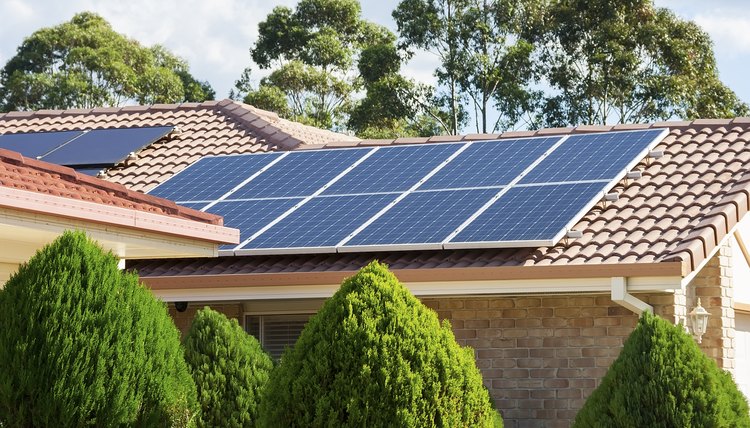The Effects of the Angle of Sunlight on a Solar Panel

The positioning of solar panels determines the power output. The angle of the sun in relationship to the angle of the solar panel determines the maximum power density. The tilt angle has the biggest effect on the efficiency of the solar panel. When the angle of the sun is perpendicular to the solar panel, it provides the maximum energy output.
Fixed Tilt
A fixed tilt solar panel is the most common type. It is more convenient and less expensive to install. A fixed tilt panel is angled to receive the maximum benefit from the sunlight year-round, according to the Department of Energy. The correct angle is found by using the homes latitude and correction for true Azimuth, true north as opposed to magnetic north. The National Geophysical Data Center has an online declination calculator that given the longitude and latitude can do this for you.
Northerly regions with longer winters use steeper tilt angles for longer winter loads. Southern regions with longer summers use lower tilt angles for a greater fraction of light in the summer months.
Horizontal Tilt
Horizontal tilt solar panels are installed on a flat roof or the ground. The angle of the sunlight would be perpendicular at noon. This would be the point of highest energy efficiency. Horizontal, or 0 degree tilt, is not the most efficient angle for solar panels, but it does allow for seamless integration into building design. Horizontal solar panels and tiles are used on existing and new buildings in Building Integrated Photovoltaics, or BIPV.
BIPV is a solar technology that uses photovolaics in building design. Photovoltaic solar cells are integrated into the building material and used to make walls, roofs and other areas in building to provide savings in energy and materials. The Department of Energy’s Western Area Power Administration’s building in Elverta, California was retrofitted with horizontal tilt solar panel tiles in 1996. The site was an ideal location for 0 degree tilt tiles. It is at 38-degree latitude, dry, sunny most of the year and has no shading, according to the Department of Energy.
Variable Tilt
Variable tilt solar panels are the most efficient at energy production. This is because they track the sun and keep the panel perpendicular to the angle of the sun. This provides the highest energy output. Variable tilt panels, also called tracking panels, will increase energy production up to 50 percent for some months and by as much as 35 percent over the year, according to the Department of Energy’s Solar Energy Technologies Program.
Tracking panels are more expensive as they require tracking structures that follow the sun using various mechanisms. The Department of Energy recommends finding accurate solar data for your location because using inaccurate data will cause design flaws.
Seasonal Tilt Adjustments
Fixed tilt panels can be adjusted at different times of the year to increase energy output. Adjusting the panels twice a year will gain the maximum performance from the panels. The summertime tilt should be low as the sun is high in the sky. The winter tilt would be a higher angle, as the winter sun is typically lower. Using a simple ratchet system attached to the solar panel mount is the easiest way to change the tilt angle.
Writer Bio
Caroline Thompson is a professional photojournalist who has been working for print and online publications since 1999. Her work has appeared in the "Sacramento Bee," "People Magazine," "Newsweek" and other publications. She holds a Bachelor of Arts in photojournalism from California State University at Hayward and a personal trainer certification from the university's Health and Fitness Institute.
